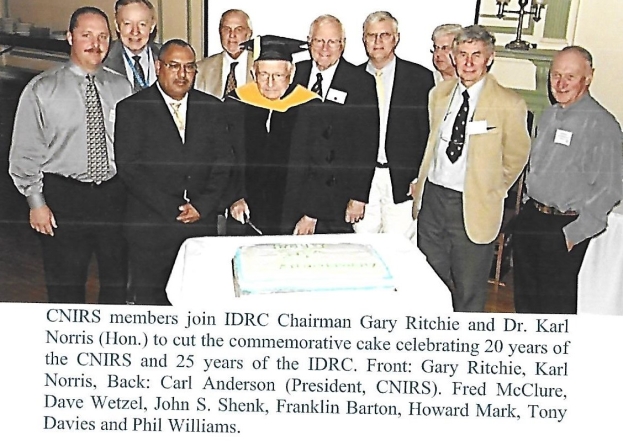A Quick Note on Karl Norris
Contribution by Gary Ritchie

This summary is from work that Karl brought to my attention. He had asked me if I would collaborate with him on writing up some experiments on the Chambersburg Shoot-out 2002 data set.
(On Calibration Transfer) (Journal of Pharmaceutical and Biomedical Analysis 48 (2008) 1037–1041.
In his own words, Karl discuss’s what utility he saw in the data set that Emil Ciurczak developed and that I produced with a young and enthusiastic team of scientists at the Purdue Pharma Global Research Center in Ardsley, NY.
Karl was gracious in acknowledging our contribution to his work. This was characteristic of him. He expressed his hope that I would agree to help him, mostly in explaining the regulatory implication of specificity as it is applied to pharmaceutical tablets, but also some nuances of the data set. I accepted. While this work brought me closer to Karl the scientist, what I really enjoyed most about Karl were the few times I got to visit with him at the Chambersburg Conferences and several other meetings where he presented and where he exhibited his sense of wit, humor and his coolness. Not only has the 2002 Chambersburg data set made it around the world multiple times as a teaching and diagnostic tool since its development, but Karl saw its potential for use on demonstrating an idea he was developing based on some of his observations on NIR specificity. He theorized that specificity could be demonstrated by showing that if the first principal component spectrum is shown to match the spectrum of the Active Pharmaceutical Ingredient (API), difference (high assay - low assay) and averaged spectra from two MultiTab transmission instruments extracted from the original data set files; the criteria for specificity could be met. In fact, he believed the new criteria demonstrated from this novel approach could serve as a Figure of Merit establishing causality of the correlation (r) regression and bias based solely on the API and not analogs or API degradants. He theorized that the Chambersburg data set was optimal for testing a hypothesis for specificity of NIR spectra because of:
1. The many samples (thus spectra), measured on two instruments,
2. The API has relatively narrow absorption bands (covering both short and long wavelengths) and
3. The instrument noise is low enough to permit little smoothing. These features were significant to Karl because they lent themselves to applying several tools he had in his tool box and honed over his career for developing strategies for analysing NIR spectra: API extraction, spectral subtraction and derivatization. Karl revealed several properties of NIR specificity based on his observations with this data set. Because he showed that it is possible to extract spectra from the data set that matched the spectrum of the API, he postulated that:
1. Since spectra were used from two instruments, spectra from both instruments were included in the high and low value sets, and averaging the spectra reduced the effect of instrument noise to provide a better match to that of the API spectrum.
2. By using this second-derivative conversion, regions of the extracted and API spectrum show enhanced absorption features, producing negative peaks that can then be used for comparison at the wavelengths of the absorption bands to more clearly show the degree of match. The positions of the negative peaks are the best evidence that the spectra match.
3. The spectra of the first principal component, the API, and the extracted spectrum should match very well after converting each to the second-derivative format.
Based on these observations following the comparison, Karl took the necessary leap and made a bold proclamation: all [15 of the] negative peaks of the API and the extracted spectrum match on the wavelength scale within 1 data point to that of the first principal component (PC 1). This provides assurance that a calibration is specific for the API.
But Karl did not stop there. He challenged his own conclusion by performing other pre-treatments combined with outlier removal, and in separate experiments, adding noise to the extracted spectral data set to demonstrate the robustness of this method for determining specificity. Only after further meticulous experimentation does Karl relax and comment that the utility of this procedure for NIR specificity differs from other tests proposed for specificity that depend on the use of active substances or excipients close to the API tested and forced degraded samples. Instead, he proposes the novel use of the high–low extracted spectra and compares their differences to the first principal component spectrum of the model and the pure API spectrum for verifying specificity of the calibration model, and for showing the suitability of its intended use for assaying API concentration.
In other words, to paraphrase Karl, the correlation (r) regression and bias of a NIR calibration model may be shown to be due to the range, signal to noise and absorption properties of the API spectrum solely and need not to be shown using analogs of the API as surrogates for specificity. In this one exercise, we get to peek inside the meticulous mind that Karl possessed by following his observations, his line of inquiry by experimentation and to also being touched by his bold and courageous heart.
Here are two of my favorite photographs from IDRC 2006
(Karl is in the centre of both of them)
.






